
PREV ARTICLE
NEXT ARTICLE
FULL ISSUE
PREV FULL ISSUE
1792 WASHINGTON CENTS IN NEWMAN PART VHere are some more headline lots in the upcoming Heritage sale of Part V of the
Eric P. Newman collection. These 1792 Washington Cents are hugely important in the saga of the
development of our fledgling nation's coinage. Wow! -Editor
1792 Washington President Cent
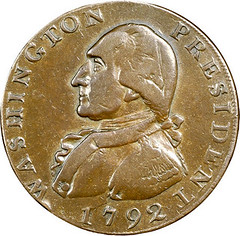 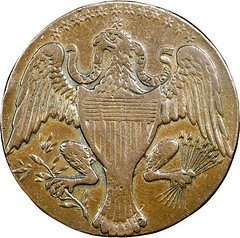 1792 Washington President Cent, Eagle and Stars Reverse. T Below Bust. Lettered Edge. XF40 NGC. Baker-21B, Breen-1228, 1995 COAC WA.1792.5, W-10685, Unique. 175.4 grains, 99% copper per NGC metallurgical tests. There are two major types of the Washington President cents distinguished by their reverses, featuring either an eagle and 13 stars or the General of the American Armies. Many subscribe to the traditional viewpoint that these pieces are closely related to the 1791 Large Eagle and Small Eagle cents; they are typically attributed to the same engraver, John Gregory Hancock, Jr. Described as a child prodigy, Hancock was employed by Obadiah Westwood’s private mint in Birmingham, England. George Fuld explains in his 1995 ANS Coinage of the America’s Conference article “Coinage Featuring George Washington:” “Although no direct evidence exists as to the origin of this series, die punch linkage and style directly link the 1792 British issues to J.G. Hancock and Westwood’s Mint. Clearly they must have been manufactured between the time of the 1792 cents and before knowledge of rejection of monarchical portraits by Congress [March 1792]. Breen conjectures that for the eagle reverse with no denomination, the strikings in copper, silver and gold represented cent, half dollar and ten dollar samples, while Newman believes the gold and silver specimens were too different from any circulating coin to be usable.” However, evidence suggests that these pieces and the related Washington Born Virginia coppers were made on the American shore, specifically at the oceanside town of Newburyport, Massachusetts. In "Perkins and the Washington Medal," published in the August 2010 issue of The Numismatist, John J. Kraljevich, Jr. presents compelling evidence that a talented young American engraver, Jacob Perkins, was the author of these 1792 Washington pieces. To view the complete auction lot description, see:
1792 Washington President Plain Edge Cent, General of the Armies Reverse
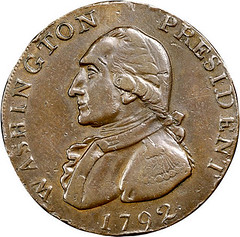
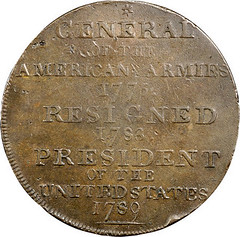 1792 Washington President Cent, General of the Armies Reverse, Plain Edge XF45 NGC. Baker-59, Breen-1234, 1995 COAC WA.1792.6, W-10690, R.6. 181.9 grains, 99% copper per NGC metallurgical tests. As noted in the previous lot, compelling evidence places the production of the 1792 Washington President cents at Newburyport, Massachusetts, from the hand of a talented young engraver named Jacob Perkins. However, others including Eric P. Newman hold the traditional numismatic viewpoint that these pieces were coined at Westwood’s private mint in Birmingham. The Washington Born Virginia obverse die was in the possession of the Perkins family until at least the late 19th century. One of the three varieties of Washington Born Virginia coppers shares the same reverse as this variety, and a second variety with that obverse shares the same reverse of the example in the previous lot. All of these pieces were clearly made by the same hand. Until John Kraljevich presented his compelling evidence, everyone believed these pieces were made in England. As truly American productions, the Washington President and Washington Born Virginia coppers are elevated to their rightful place among the most important pieces in the Early American field, equally as important as the Getz patterns. With an estimated population at fewer than 30 pieces, these coppers are even rarer than those made by Getz, and they should be considered every bit as valuable, if not more so. To view the complete auction lot description, see:
1792 Baker-25 Washington President Cent

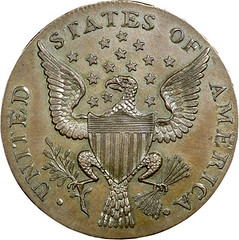 1792 Getz Washington President Pattern Cent, Plain Edge MS64 Brown NGC. Baker-25, Breen-1352, Pollock-5020, W-10775, R.5. Ex: "Col." E.H.R. Green. 257.7 grains, 99% copper per NGC metallurgical tests. The late Jack Collins spent many years studying the Getz silver and copper Washington President pieces. Unfortunately, he passed away before the study was completed. His friend, George Fuld, continued the study through completion, and in 2009 The Washington Pattern Coinage of Peter Getz was published by George Frederick Kolbe and Alan Meghrig. The Peter Getz pattern coins were minted in silver and copper. Those struck in silver include 14 with a plain edge, five with the Circles and Squares edge, and three with the twin olive leaves edge. Copper impressions include 45 with a plain edge and 11 with the Circles and Squares edge. Among those 56 copper pieces are eight examples that are described as Mint State. The Eric P. Newman coin is the fifth finest of those eight pieces. An arcing planchet cutter mark is visible from the bottom of the 1 to the top of the G, continuing to the border over the A. The entire obverse is double struck, with less noticeable reverse doubling. The surfaces are prooflike, and the design motifs are bold. Both sides have attractive chocolate-brown surfaces with delicate light green toning highlights. An exceptional Getz copper. There were many Washington pieces made as tribute pieces in England, but those by Getz were actually made in the U.S., and are considered pattern coins as opposed to Washington pattern issues. While they were made outside the mint, they were struck in Philadelphia on a coin press that was soon moved to the new Philadelphia Mint. It is our opinion that these pieces should be collected as part of the United States pattern series, and they are listed in Andrew Pollock's pattern reference. These pattern coins are attributed to Peter Getz of Lancaster, Pennsylvania, apparently on the strength of remarks made by J. Franklin Reigart of that town, and published by Montroville Wilson Dickeson in The American Numismatical Manual: "Mr. Getz was personally complimented by Washington for his artistic skill in producing the die for what is called the 'Washington Cent,' and it was also officially recognized by the Government. This letter was often exhibited by Major John Getz, a son of the artist, during his lifetime. Memory must, however, supply the place of this documentary proof, as it cannot now be found." To view the complete auction lot description, see:
1792 Roman Head Cent
 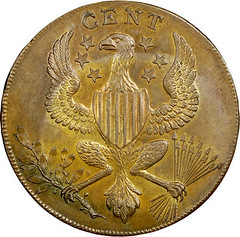 1792 Washington Roman Head Cent PR65 Red and Brown NGC. Baker-19, Breen-1249, W-10840, R.6. 197.5 grains, 99% copper per NGC metallurgical tests. The edge is lettered UNITED STATES OF AMERICA. A product of Obediah Westwood's Birmingham Mint, the dies of the Roman Head cent are attributed to the talented young engraver John Gregory Hancock. Walter Breen gave Hancock's life dates as 1775-1815 in his Complete Encyclopedia and described him as a "juvenile engraving prodigy." However, Forrer's Biographical Dictionary of Medalists suggests that those dates were his active years of engraving: "Medallist and die-sinker of the latter part of the eighteenth century and first two decades of the nineteenth, circ. 1775-1815." His son, also John Gregory Hancock (born 1791) was described as a prodigy who was engraving tokens at the age of eight or nine years. If the elder Hancock was born in 1775, he was just 16 years old when his son was born. Birmingham records indicate that John Gregory Hancock and Sarah Ward were married in 1780, suggesting that the elder engraver was likely born a couple of decades earlier, perhaps around 1760. It is known that President Washington objected to the appearance of his likeness on the Federal coinage. However, the Senate version of the Mint Act called for "an impression or representation of the head of the president of the United States." The House of Representatives, apparently ceding to Washington's wishes, changed the wording to call for "an impression emblematic of liberty." As the Getz pattern followed the designs of Hancock's earlier Washington cents, this piece appeared as a response, although opinions of its purpose differ. In the Whitman Encyclopedia of Colonial and Early American Coins, Q. David Bowers wrote: "The Roman Head cent depicts Washington dressed in the style of a Roman official, a popular way of honoring him, at least in memory, but these are dated during his life. The apotheosis of Washington saw many forms, most famously in Horatio Greenough's statue of epic proportions showing Washington as a Roman emperor seated on a throne. For years this was displayed on the U.S. Capitol grounds. There are many versions of similar tributes in the classic style to be found on bank note vignettes." "When news of Washington's rejection reached Birmingham, John Gregory Hancock (doubtless with Westwood's gleeful consent, possibly at his instigation) undertook an extraordinary piece of revenge. As Washington's spokesmen had compared the idea of presidential portraits on coins to the practices of Nero, Caligula, and Cromwell, so Hancock's (and/or Westwood's) idea was to portray Washington on a coin as a degenerate, effeminate Roman emperor. Hancock's satirical masterpieces, the 'Roman Head' cents manage to convey this impression--with a subtle resemblance. ... Beginning as tokens of incredible spite, these cents have become among the most highly coveted of Washington items." To view the complete auction lot description, see:
To read the earlier E-Sylum articles, see:
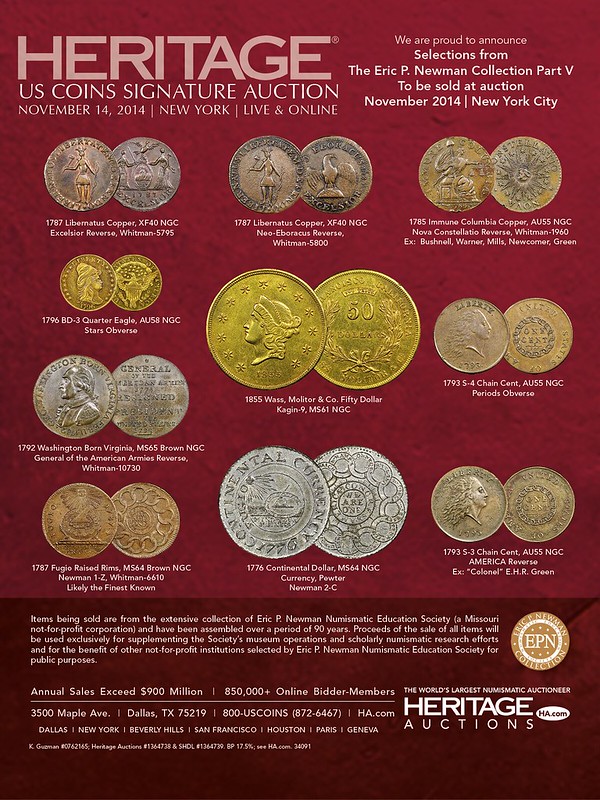 Wayne Homren, Editor The Numismatic Bibliomania Society is a non-profit organization promoting numismatic literature. See our web site at coinbooks.org. To submit items for publication in The E-Sylum, write to the Editor at this address: whomren@gmail.com To subscribe go to: https://my.binhost.com/lists/listinfo/esylum All Rights Reserved. NBS Home Page Contact the NBS webmaster 
|